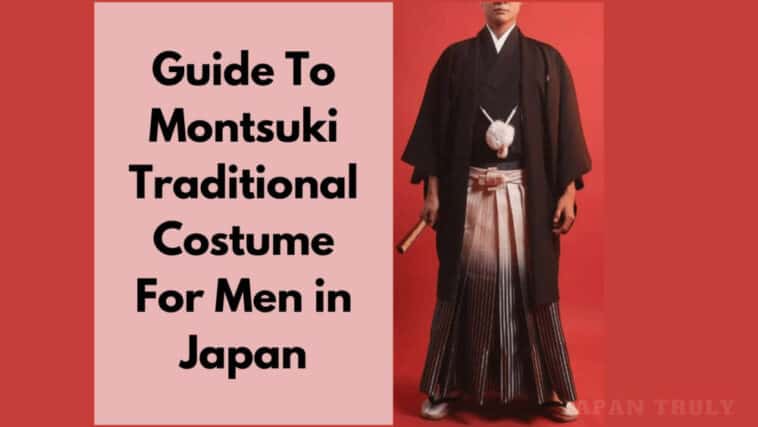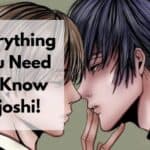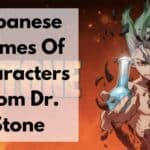Here’s everything you need to know about Montsuki traditional costume for men.
Immerse yourself in the elegance of Japanese formal wear with our guide to the Montsuki, the quintessential traditional costume for men in Japan.
Distinguished by its refined simplicity and symbolic family crests, the Montsuki kimono exudes dignity and cultural heritage, reserved for the most solemn and ceremonial occasions.
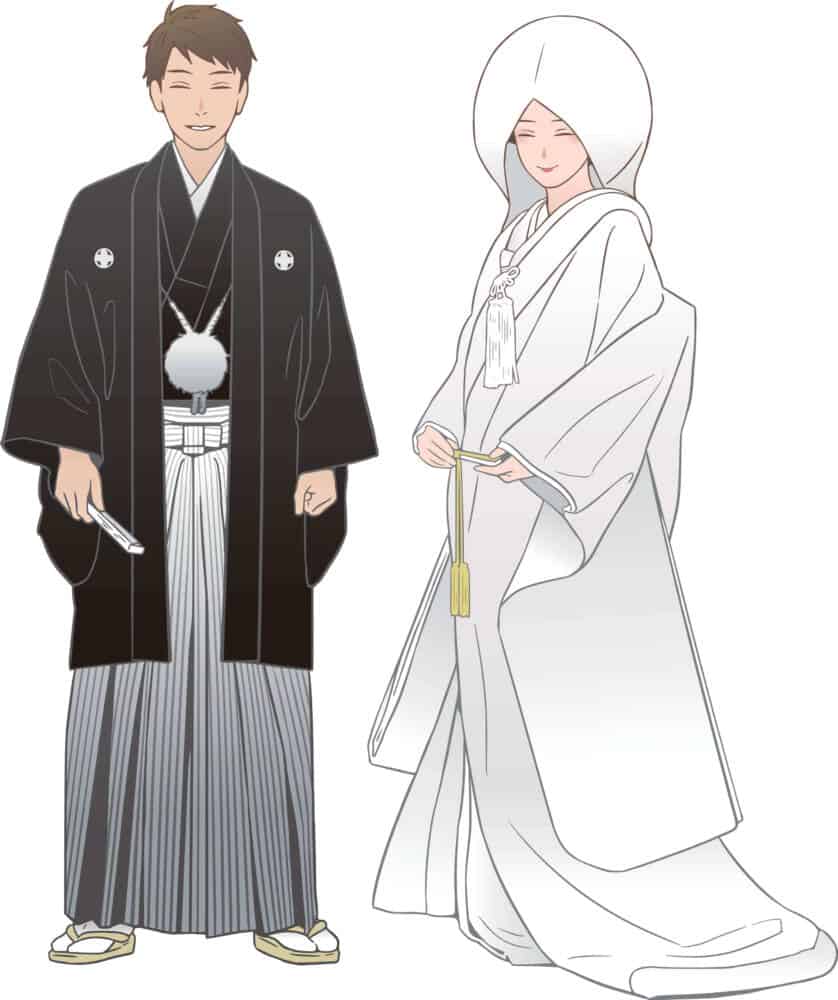
Page Contents
Montsuki Traditional Costume For Men
Montsuki Meaning

Montsuki is a type of formal kimono with family crests worn only by men on particular occasions made from a solid and smooth fabric. ‘Mon’(紋), means family crest and ‘Tsuki’ (突き) means dress.
Another name for it is Montsuki Haori Hakama and is regarded as the most formal attire for men. It comprise of a combination of the following:
A crested nagagi (a full-length Japanese garment)
A hakama (a pleated and divided Japanese skirt for men) and
Crested haori (a Japanese traditional half coat).
The Origin of the Montsuki Costume:
During the Edo period, the people of the samurai society were first seen wearing the Montsuki. What started out as a simplified formal attire, became a standard formal wear for all common men in the middle of the Edo period.
The Montsuki then became a very popular garment during the Meiji period because of the decree of the Grand Council of State designated- ‘black haori hakama bearing five family crests’ as the official formal attire.
Ever since the decree’s provision to wear the Montsuki as the first formal costume, it is now generally considered as formal Japanese attire and clothing. However, the traditional religions and arts of performance people do not necessarily consider Montsuki Haori Hakama formal.
The provision did not allow the Montsuki costume to bear any medals of the first order of merit or a higher one.
Formal attire of the samurai society in the Edo period was dependent on official ranks such as hitatare, kariginu and daimon which was worn by feudal lords and suo which was worn by lower ranks.
The Montsuki Haori Hakama is considered lower than a swallow-tailed coat (most formal western clothes) and is equivalent to a morning coat or frock coat (second class formal western clothes).
Any kind of nagagi could be worn under haori during the Edo period but now a kuro montsuki or a black crested garment is worn commonly.
People can be seen wearing a traditional kimono and haori coat, with crest marks on both left and right spots of the breast part and sleeves and on the back as well, on many prestigious occasions and events like an exchange of betrothal gifts, name-taking ceremonies, and funerals.
- Related: Why Japanese Wear Kimono
- Related: Types Of Kimono
What Does the Montsuki Costume Consist Of?
Official Crests marks:
The Montsuki Haori Hakama is made up of a black and highest class silk called Habutae with five family crest marks. Even though five is formal, even three or four family crests are also allowed.
The black Montsuki is also called Kuro Montsuki which is considered the most formal color and type for this male costume. Keep in mind that Montsuki is only part of the complete attire.
These official crest marks are dyed by having the patterns undyed on its black field and sewing the crest marks. During the summer season, people may wear haori and nagagi made from sha or silk gauze and ro gauze fabrics. Men also wear crested clothing of colors other than black too.
Braids:
Braids are tied in front of the pit of the stomach by putting clusters over. A flower tie and other tying methods are considered informal.For formal occasions, people use white flat braids, round braids and other type braids as well.
During the Meiji period, it was a practice to use gray color braids on the occasion of funerals.
Belt:
Kaku Obi is a stiff sash used by men
Hakama:
As mentioned earlier, it is a formal pleated and divided skirt worn by men.
Usually, you can see men wearing both an andon-bakama which is a type of tubular hakama skirt and umanori bakama which is a horse-riding style skirt.The hakama skirts are made using silk fabrics of a broad-striped pattern like Sendai-hira. A plain hakam is considered informal.
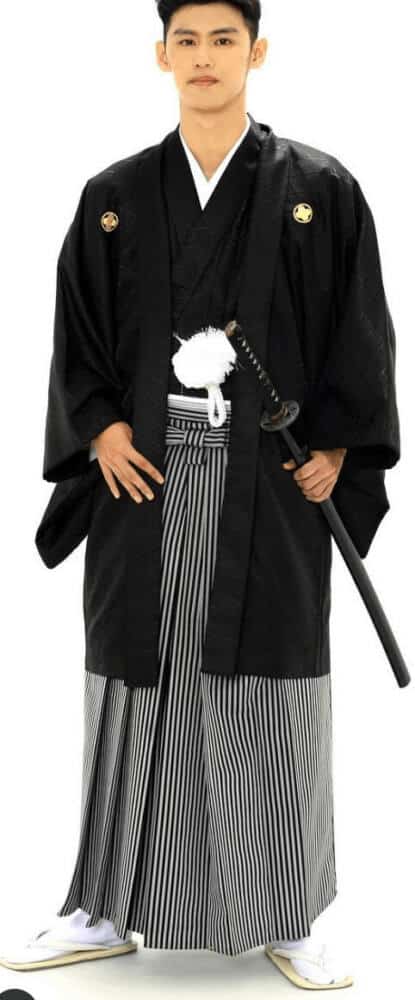
Tabi
These are Japanese digitated socks. Only white tabi socks have to be worn for the Montsuki Haori Hakama style.
Footwear:
The setta are Japanese traditional sandals with white thongs that have to be worn for this style.
Sensu
This is a folding fan. A White-ground sensu is usually held by the person wearing the garment.
When to Wear a Montsuki Costume?
A Montsuki Haori Hakama can be worn on a number occasions:
- On the occasion of a wedding ceremony, the Montsuki Haori Hakama is worn by the groom, father and men of the couple and other guests.
- On the occasion of a funeral, the Montsuki Haori Hakama is worn in black and gray color. The braids of the haori coat color is usually white.
- On the occasion of a ceremonial exchange of betrothal gifts.
- On the occasion of the announcement of somebody’s succession to a professional name ceremony. For example, a rakugo-ka or a comic story teller will wear the Montsuki Haori Hakama on the occasion of a ceremony for announcement of his succession to the new name.
- On the occasion of ozumo or a grand sumo tournament. Sekitori or sumo wrestlers ranked in the top two divisions wear the Montsuki Haori Hakama as their formal dress. The shinpan-in or shobu-shinpan or ringside judges who may claim their objection against the referee’s decision also wear the Montsuki Haori Hakama.
- A Rakugo-ka is allowed to wear the Montsuki Haori Hakama after he gets a promotion of two stages.
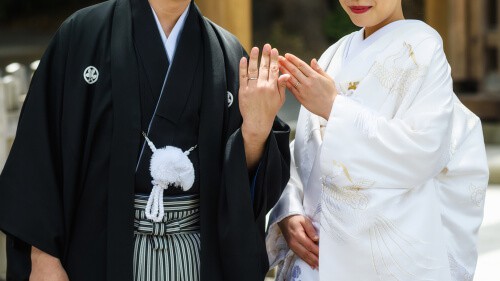
How to Wear a Montsuki Costume?
The traditional Montsuki Haori Hakama is quite charming because of its style, uniqueness and traditional aesthetic. The rules for kimono and montsuki costume are quite strict
You wrap the kimono or montsuki left over right, because the other way around is ‘reserved’ for the people who died. It follows the body and does not spread like a long skirt.
- Pull the ends forward and make sure they are at an equal height.
- Always wrap the kimono or montsuki with the left side over the right.
- Make sure at the center of your body, the fold at the back.
- To prevent the kimono or montsuki from opening again, use a kaku obi.
- Make sure the kimono and montsuki follows the body and is not worn wide like a skirt.
- Place your haori on top of your montsuki which will increase the level of formality.
- When wearing your hakama, you can knot it in several ways: ichimonji is the common semi formal knot tucked up into the obi at the back which resembles a bow tie. The most formal knot is junoji which resembles the kanji for the number 10, a simple square knot can be done for a casual feel.
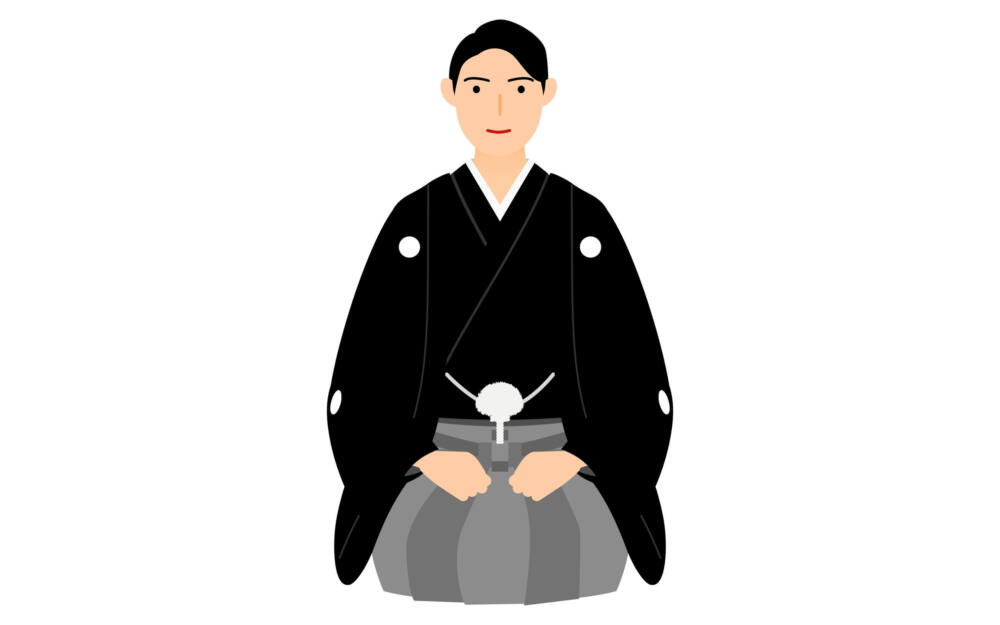
- Related: Modern Japanese Kimono Fashion
Montsuki: FAQs
What is the difference between men and women’s kimonos?
The major differences lie in the color: while men’s kimonos are more subtle in color with gray, black or brown, women’s kimonos are vibrant with pink, red and purple. While men’s kimonos have strong patterns like a family crest, women’s kinos have natural elements embroidered into them.
What are the types of fabric used for making any Japanese traditional clothing?
Usually, a superior silk fabric or spun silk or a habutai silk is used for making traditional clothing like kimonos because of the lightweight and shimmering materials. The summer kimonos are made of a casual cotton fabric with blue and white colors.
Where can you buy a montsuki?
They can be ordered from specialized stores or in a department store. You can purchase them as a single length of cloth around 16 feet long, or even rent it for formal occasions or buy one secondhand.
Conclusion:
I absolutely adore everything about Japan. Learning more about their culture and traditional attire just makes me respect the country, even more. Though many people first consider a kimono or any type of traditional clothing to be a Japanese women’s dress, it’s important to always understand that men wear these kinds of clothing on special occasions too.
Any distinguished gentlemen or men attending a formal situation will wear a Montsuki attire with good material quality.
Anyway, you can see them wearing this mainly for traditional ceremonies and special occasions. What do you think of this Japanese attire called Montsuki? Did you already know about it? I really hope you enjoyed reading the article, we appreciate all your comments and shares.
Also Read


